ここから本文です。
Circumference Guidance
Circumference Guidance
 Kagawa Prefectural Higashiyama Kaii Setouchi Art Museum
Kagawa Prefectural Higashiyama Kaii Setouchi Art Museum- Seto Ohashi Bridge Commemorative Park
- Shamijima Island
- ①The Site of Shami Nakanda Beach
- ②Monument in Memory of Poems by Kakinomoto Hitomaro
- ③Hitomaro Rock
- ④Kakinomoto Hitomaro Monument
- ⑤Monument in Memory of the Novel, “Eternal Love”
- ⑥Stone Coffin at Nagasaki-no-hana Point
- ⑦Shiroishi Kofun
- ⑧Shiroishi Kofun Square
- ⑨Rigen Daishi Hall
- ⑩Senninzuka
- ⑪Site of Shiroyama
- ⑫Man’yo Hall
 Kagawa Prefectural Higashiyama Kaii Setouchi Art Museum
Kagawa Prefectural Higashiyama Kaii Setouchi Art Museum
Kaii Higashiyama(1908-1999)is a celebrated Japanese Landscape painter. After he passed away, his family generously donated more than 270 lithographs to Kagawa Prefecture, since the painter's grandfather was from Hitsuishijima Island of Sakaide in Kagawa. The Prefecture therefore decided to build this art museum to display those works and offer opportunity to the public to appreciate his art.
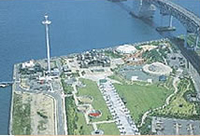 Seto Ohashi Bridge Commemorative Park
Seto Ohashi Bridge Commemorative Park
This park was built to commemorate construstion of the Seto Ohashi Bridge. After going though the entrance and "Water Promenade" with various fountains, you will get to the Seto Ohashi Bridge Commemorative Hall, where you can learn history of the Seto Ohashi Bridge construction and techniques applied to the construction works. Filled with water and green areas, such as "Lawn Yard" and "Hama-Ritsurin," you can enjoy a panoramic view of the Seto Inland Sea from this spacious park. A big observation platfrom also commands a spectacular night view.
The earliest human occupation in shamijima Island dates back to Palaeolithic period. As a result of continuous human use of this island, there are a number of archaeological sites from various periods, such as Jomon, Yayoi, Kofun,Ancient, and Medieval periods. IT is also a well-known island where Kakinomoto Hitomaro,'The sage of Poems' in Man' yoshu (The Anthology of Thousand Leaves) stopped over in the late seventh century. since then, many people including the intellectuals, who adore Hitomaro and Man' yoshu, have visited this 'Island of Literature.' Shamijima Island is also famous for a aplendid view of the Seto Ohashi Bridge from Nakanda Beech.
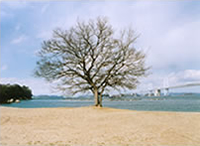 ①The Site of Shami Nakanda Beach(prefectually designated cultural property in 1989.)
①The Site of Shami Nakanda Beach(prefectually designated cultural property in 1989.)
Located in a beach, this ancient salt-making site,which was reported by a local historian Sadatsugu Terada in 1938, remains unusually in good condition among sites within the prefecture.Containing archaeological features from Jomon, Yayoi and Kofun periods, this is regarded as a precious salt-making site, since two kinds of rare hearths, that is, a stone-paved hearth and a salt-roasting hearth, were found. You can also enjoy a spectacular view of the Seto Ohashi Bridge from this Nakanda Beech.
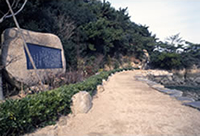 ②Monument in Memory of Poems by Kakinomoto Hitomaro
②Monument in Memory of Poems by Kakinomoto Hitomaro
In 1988, the Kagawa association of Japanese Education put up "The Monument in Memory of Poems by Kakinomoto Hitomaro,"One long poem and two envoys, composed by Hitomaro in Samijima, were inscribed on the monument. Callingraphy of the whole poems was written in a mixture of Chinese and Japanese characters by Toson Tenseki, who used to be a judge of the Nitten Exhibition.
A massive rock on the Osogoe Beach is called "Hitomaro Rock," It is said that Hitomaro compased one long poem and two envoys when he witnessed a dead around the rock. The long poem begins with a famous phrase, "the land of Sanuki, fine in sleek seaweed..."
Wishing that people could sympathize with the heart of Man' yo through Hitomaro, anovelist from Sakaide Yoichi Nakagawa built this monument in 1936. At that time, facing toward the Seto Inland Sea, the monument was originally built on the east side of the Nakanda Beach. In 1984, when a walking trail was improved, it was moved near to the Hitomaro Rock on the Osogoe Beach where he composed the famous poems. Calligraphy of the monument was written by poet, Jun Kawada.
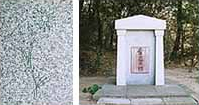 ⑤Monument in Memory of the Novel, “Eternal Love”
⑤Monument in Memory of the Novel, “Eternal Love”
Yoichi Nakagawa, a novelist from Sakaide, started to publish the serial story, "Eternal Love" on Asahi Newspaper in 1935. Pursuing dignity of love, the novel brought fresh sensitivity to Japn's literary world. The last chapter of the story described nature of Shamijima. In 1977, a national volunteer group erected a Greek-temple-style monument with inscription of a "Yomena" motif, a kind flower associated with Man' yoshu. The monument was designed by Keiichiro Taniguchi, an architect and a recipient of the Order of Cultural Merit, and its front earthen slab was made by Kei Fujiwara, a Bizen ware potter, who was designated as a Living National Treasure.
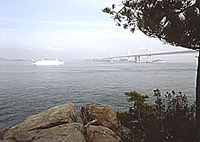 ⑥Stone Coffin at Nagasaki-no-hana Point
⑥Stone Coffin at Nagasaki-no-hana Point
A slab coffin, which is believed to date back to the late Yayoi Period, was found at the head of narrow ridge in Nagasaki-no-hana Point. Although no burial goods was rare in this prefecture, was found. A broken jar of Yayoi pottery. which was left upside-down, was discovered from the outside of the coffin.
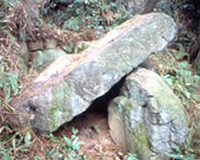 ⑦Shiroishi Kofun(Burial Mound)
⑦Shiroishi Kofun(Burial Mound)
Built on a land overlooking the Nakanda Beech, the Shiroishi Kofun has a stone burial chamber with horizontal passageway, which dates back to the late Kofun Period (the late sixth century).Although most of the ceiling slabs are missing, this burial mound is the largest in Shamijima after the Sennin Burial Mound. Burialgoods found in the chamber include Sue ware, Kinkan (a gold or metal ring with open ends, used as ear ornament), and pottery in Shiyaku style, which have been found at theNakanda Beech.Archaeological research shows that Shamijima prospered as a salt extraction place, centering on the site of Nakanda Beach. It is believed that a chief of this salt-making island was buried in the mound. Artifacts found here have been exhibited in the Sea House.
Located on a height continuing to Shiroyama, a viewing platfrom is placed by the Environment Agency. It commands an extensive prspect of the Seto Inland Sea tonthe north:islands such as Yoshima, Honjima, and Hitsuishijima, are seen closely: the Washuzan Mountain and the Mizusima Factory Park in Okayama Prefecture are seen in the distance. The viewing platform is also a good place to rest, equipped with benches.
Built by Shobei Mizobuchi and other people of this island in Edo Period, this hall was dedicated to a Buddhist monk Rigen Daishi (the Great Master of Holy Treasures), one of the five best Buddhist monks from the sanuki Province. It is believed that Rigen Daishi was born in Shamijima, and he was sixteen years old. He is knows for his great contributions to restoration of Buddhism, Buddhism through ascetic practices, and carrying out public-works projects. Right beside the hall, there is a stone basin, which was allegedly used to give him its first bath.
Located on the top of the western ridge, this third- or fourth -century burial mound has a terraced square-plan, about eleven meters each side and two meters in height, surrounded with two-tiered stone alignments. The entrance of the stone burial chamber with vertical access used to be opened, but it is closed today. This burial mound became a prefectually designated cultural property in 1970. The burial mound is surrounded by many small mounds, which were once regarded as satellite burial mounds. The excavation that they date back to the eighth century, namely, the last phase of the Kofun Period, and therefore, these small mounds are not satellite burial mounds of Senninzuka.
The site of Shiroyama has been seen as a fort or a watchtower built by the Shiwaku Navy in the Medieval Period. Two-stage stone walls were constructed to enclose the top of the hill. From ancient times, the Shiwaku Islands have been key junctions the marine traffic. Therefore, the Shiwaku Navy played an important part in this region. The archaeological evidence from the site has shown that the Shami area was one of the strategic points for the Shiwaku Navy. The site was a subject of the nationwide investigation of the Medieval Castle and Forts conducted recently, because the structure of the medieval fortification remains well at Shiroyama.
In 1987, this hall was constructed to offer public places for cultural and artistic activities, such as performances and practices of traditional cultures and fork entertainment. In 1999, the name of the hall changed from "Community Hall for Friendship" into "Man'yo Hall" to give good publicity to this island of Man'yo.
View Video
- Shamijima Island
Broadband(6.95MB),Narrowband(712KB)
このページに関するお問い合わせ
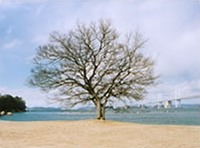 Shamijima Island
Shamijima Island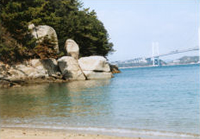 ③Hitomaro Rock
③Hitomaro Rock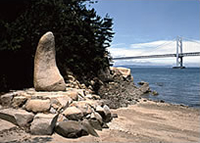 ④Kakinomoto Hitomaro Monument
④Kakinomoto Hitomaro Monument ⑧Shiroishi Kofun Square
⑧Shiroishi Kofun Square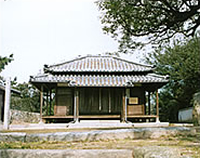 ⑨Rigen Daishi Hall
⑨Rigen Daishi Hall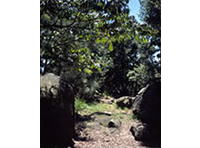 ⑩Senninzuka
⑩Senninzuka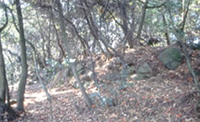 ⑪Site of Shiroyama
⑪Site of Shiroyama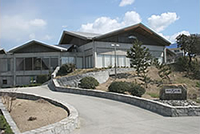 ⑫Man’yo Hall
⑫Man’yo Hall